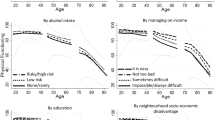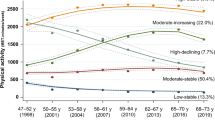Abstract
Large family size and early parenthood have been associated with adverse health outcomes in old age whereas there is increasing evidence of the beneficial effects of physical activity. We examined the extent to which physical activity might mediate and/or moderate later life health disadvantages related to a high number of children and early parenthood. We used data from five waves of the English Longitudinal Study of Ageing collected in 2002–2010 (n = 11,233 in wave 1). Latent change score modelling was used to assess the direction of the association between physical activity and functioning. An interaction term of physical activity and fertility history was added in latent growth curves for functional limitation. The models were adjusted for age, gender, smoking, educational attainment, occupational status and wealth in wave 1, with whether married and depressive symptoms included as time-varying covariates. The models suggested that physical activity serves as a mediator in the association between fertility history and the level of later life functioning. However, there was no effect of fertility history on changes in physical activity or functional limitation. Among those who were physically active, functional limitations remained at a considerably lower level and high number of children and early parenthood were not associated with poorer levels of health. Physical activity thus moderates the level of health disadvantages related to high number of children and parenthood.
Access this chapter
Tax calculation will be finalised at checkout
Purchases are for personal use only
Similar content being viewed by others
References
Aiken, A. R. A., Angel, J. L., & Miles, T. P. (2012). Pregnancy as a risk factor for ambulatory limitation in later life. American Journal of Public Health, 102, 2330–2335.
Baert, V., Gorus, E., Mets, T., Geerts, C., & Bautmans, I. (2011). Motivators and barriers for physical activity in the oldest old: A systematic review. Ageing Research Reviews, 10, 464–474.
Blake, H., Mo, P., Malik, S., & Thomas, S. (2009). How effective are physical activity interventions for alleviating depressive symptoms in older people? A systematic review. Clinical Rehabilitation, 23, 873–887.
Choi, J., Fukuoka, Y., & Lee, J. H. (2013). The effects of physical activity and physical activity plus diet interventions on body weight in overweight or obese women who are pregnant or in postpartum: A systematic review and meta-analysis of randomized controlled trials. Preventive Medicine, 56, 351–364.
Davenport, M. H., Giroux, I., Sopper, M. M., & Mottola, M. F. (2011). Postpartum exercise regardless of intensity improves chronic disease risk factors. Medicine and Science in Sports and Exercise, 43, 951–958.
de Oliveira, C., Shankar, A., Kumari, M., Nunn, S., & Steptoe, A. (2010). Health risk and health protective biological measures in later life. In J. Banks, C. Lessof, J. Nazroo, N. Rogers, M. Stafford, & A. Steptoe (Eds.), Financial circumstances, health and well-being of the older population in England: The 2008 English Longitudinal Study of Ageing (pp. 275–347). London: The Institute of Fiscal Studies.
Enders, C. K., & Bandalos, D. L. (2001). The relative performance of full information maximum likelihood estimation for missing data in structural equation models. Structural Equation Modeling-a Multidisciplinary Journal, 8, 430–457.
Galobardes, B., Shaw, M., Lawlor, D. A., Lynch, J. W., & Smith, G. D. (2006). Indicators of social position (part 2). Journal of Epidemiology and Community Health, 60, 95–101.
Grundy, E., & Read, S. (2015). Pathways from fertility history to later life health: Results from analyses of the English Longitudinal Study of Ageing. Demographic Research, 32(4), 107–146.
Grundy, E., & Tomassini, C. (2005). Fertility history and health in later life: A record linkage study in England and Wales. Social Science and Medicine, 61, 217–228.
Henretta, J. C. (2007). Early childbearing, marital status, and women’s health and mortality after age 50. Journal of Health and Social Behavior, 48, 254–266.
Hobcraft, J. (2008). The timing and partnership context of becoming a parent: Cohort and gender commonalities and differences in childhood antecedents. Demographic Research, 19, 1281–1322.
Kendig, H., Dykstra, P. A., van Gaalen, R. I., & Melkas, T. (2007). Health of aging parents and childless individuals. Journal of Family Issues, 28, 1457–1486.
Koeneman, M. A., Verheijden, M. W., Chinapaw, M. J. M., & Hopman-Rock, M. (2011). Determinants of physical activity and exercise in healthy older adults: A systematic review. International Journal of Behavioral Nutrition and Physical Activity, 8, 142.
McArdle, J. J., & Hamagami, F. (2001). Linear dynamic analyses of incomplete longitudinal data. In L. Collins & A. Sayer (Eds.), Methods for the analysis of change (pp. 137–176). Washington, DC: American Psychological Association.
McEwen, B. S. (2003). Interacting mediators of allostasis and allostatic load: Towards an understanding of resilience in aging. Metabolism-Clinical and Experimental, 52, 10–16.
Muthén, L. K., & Muthén. B. O. (1998–2012). Mplus user’s guide. Los Angeles, CA: Muthén & Muthén.
Pavey, T. G., Anokye, N., Taylor, A. H., Trueman, P., Moxham, T., Fox, K. R., et al. (2011). The clinical effectiveness and cost-effectiveness of exercise referral schemes: A systematic review and economic evaluation. Health Technology Assessment, 15, 1–254.
Physical, Activity, Guidelines, Advisory, & Committee. (2008). Physical activity guidelines advisory committee report. Part G, Section 6: Functional health. Washington, DC: US Department of Health and Human Services. http://www.health.gov/paguidelines/Report/pdf/CommitteeReport.pdf.
Powell, K. E., Paluch, A. E., & Blair, S. N. (2011). Physical activity for health: What kind? How much? How intense? on top of what? In J. E. Fielding, R. C. Brownson & L. W. Green (Eds.), Annual Review of Public Health, 32, 349–365.
Read, S., Grundy, E., & Wolf, D. A. (2011). Fertility history, health, and health changes in later life: A panel study of British women and men born 1923–49. Population Studies-a Journal of Demography, 65, 201–215.
Rhodes, R. E., Mark, R. S., & Temmel, C. P. (2012). Adult sedentary behavior a systematic review. American Journal of Preventive Medicine, 42(3), E3–E28. https://doi.org/10.1016/j.amepre.2011.10.020.
Shankar, A., McMunn, A., Banks, J., & Steptoe, A. (2011). Loneliness, social isolation, and behavioral and biological health indicators in older adults. Health Psychology, 30, 377–385.
Speck, R. M., Courneya, K. S., Masse, L. C., Duval, S., & Schmitz, K. H. (2010). An update of controlled physical activity trials in cancer survivors: A systematic review and meta-analysis. Journal of Cancer Survivorship-Research and Practice, 4, 87–100.
Spence, N. J. (2008). The long-term consequences of childbearing physical and psychological well-being of mothers in later life. Research on Aging, 30, 722–751.
Spence, N. J., & Eberstein, I. W. (2009). Age at first birth, parity, and post-reproductive mortality among white and black women in the US, 1982–2002. Social Science and Medicine, 68, 1625–1632.
Stuifbergen, A. K., Morris, M., Jung, J. H., Pierini, D., & Morgan, S. (2010). Benefits of wellness interventions for persons with chronic and disabling conditions: A review of the evidence. Disability and Health Journal, 3, 133–145.
Umberson, D., Crosnoe, R., & Reczek, C. (2010). Social relationships and health behavior across the life course. Annual Review of Sociology, 36, 139–157.
Umberson, D., Liu, H., Mirowsky, J., & Reczek, C. (2011). Parenthood and trajectories of change in body weight over the life course. Social Science and Medicine, 73, 1323–1331.
van der Pligt, P., Willcox, J., Hesketh, K. D., Ball, K., Wilkinson, S., Crawford, D., et al. (2013). Systematic review of lifestyle interventions to limit postpartum weight retention: Implications for future opportunities to prevent maternal overweight and obesity following childbirth. Obesity Reviews, 14, 792–805.
von Bonsdorff, M. B., & Rantanen, T. (2011). Progression of functional limitations in relation to physical activity: A life course approach. European Review of Aging and Physical Activity, 8, 23–30.
Vuillemin, A. (2012). Benefits of physical activity on health among elderly. Science & Sports, 27, 249–253.
Warburton, D. E. R., Nicol, C. W., & Bredin, S. S. D. (2006). Health benefits of physical activity: The evidence. Canadian Medical Association Journal, 174, 801–809.
Woodcock, J., Franco, O. H., Orsini, N., & Roberts, I. (2011). Non-vigorous physical activity and all-cause mortality: Systematic review and meta-analysis of cohort studies. International Journal of Epidemiology, 40, 121–138.
Author information
Authors and Affiliations
Corresponding author
Rights and permissions
Copyright information
© 2019 The Author(s), under exclusive licence to Springer Nature B.V.
About this chapter
Cite this chapter
Read, S., Grundy, E. (2019). Physical Activity: A Moderator or Mediator in the Association Between Fertility History and Later Life Health?. In: Pathways to Health. SpringerBriefs in Population Studies. Springer, Dordrecht. https://doi.org/10.1007/978-94-024-1707-4_3
Download citation
DOI: https://doi.org/10.1007/978-94-024-1707-4_3
Published:
Publisher Name: Springer, Dordrecht
Print ISBN: 978-94-024-1705-0
Online ISBN: 978-94-024-1707-4
eBook Packages: Social SciencesSocial Sciences (R0)




